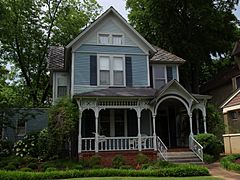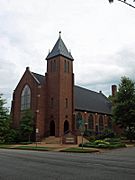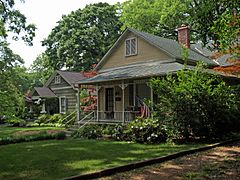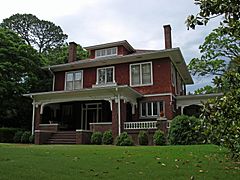Albany, Alabama facts for kids
Quick facts for kids |
|
|
Albany Heritage Neighborhood Historic District
|
|
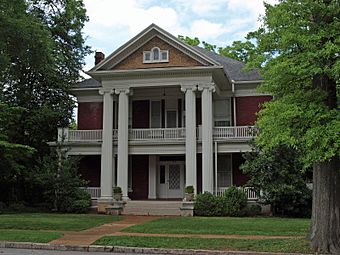
Neal-Wiley House at 646 Jackson Street, 2013
|
|
| Location | Roughly bounded by Gordon Dr., Summerville Rd., Jackson, 8th, Moulton, 6th, and 4th Aves., Decatur, Alabama |
|---|---|
| Built | 1887 |
| Architectural style | Bungalow/Craftsman, Late Victorian |
| NRHP reference No. | 83002981 |
| Added to NRHP | February 3, 1983 |
Albany, Alabama, also known as New Decatur, Alabama, was once a separate city in Morgan County, Alabama. It was located right next to the city of Decatur, near the Tennessee River. New Decatur/Albany existed as its own city from 1887 until 1927. That year, it joined with Decatur. Today, Albany is a historic neighborhood within Decatur. It is listed on the National Register of Historic Places. This means it is recognized for its important history.
Contents
A Look Back at Albany's History
Decatur's Early Struggles
The city of Decatur, Alabama, was a very important place during the American Civil War. It was a key spot for transportation. Because of this, control of Decatur often changed between the Union and Confederate armies. Sadly, most of the city was destroyed during the Battle of Decatur. Only three buildings were left standing.
Just as Decatur was starting to rebuild, a serious illness called yellow fever spread in 1878. This caused many people to leave. By 1880, only about 400 people lived there.
The Birth of New Decatur
On January 11, 1887, a group of investors decided to create a new city. They wanted to help the area grow again. These investors, including Eugene C. Gordon, bought a large piece of land. It was about 5,600 acres southeast of Decatur.
They named their new city New Decatur. They even called it "The Chicago of the South." This was because they hoped it would become a major transportation center. It was also a way to attract people from the Midwest.
A Planned Community
New Decatur was carefully planned. A famous landscape architect named Nathan Franklin Barrett helped design it. The company set aside 100 acres for churches and schools. They also created Delano Park. This park was designed to make the city's grid-like streets more interesting.
The Alabama State Legislature officially recognized New Decatur as a city on February 18, 1889.
Growth and New Names
The company advertised New Decatur as "the healthiest city in the South." They had a modern water and drainage system. This was thought to prevent diseases. Many people began to move to New Decatur. The city grew because of its industries and good quality of life.
To help bring people together, streets were named after generals from both sides of the Civil War. You can find streets named after Union generals like Grant and Sherman. There are also streets named after Confederate generals like Johnston and Jackson.
From New Decatur to Albany
New Decatur was meant to work with the older city of Decatur. However, people from "Old Decatur" were sometimes upset by the new arrivals. Many of the new residents were from the North. This caused some tension, as Civil War memories were still fresh.
In 1916, New Decatur changed its name to Albany. This helped it have its own identity. Residents chose the name to honor Albany, New York. By this time, Albany and Old Decatur had grown into a large area. They had an estimated population of 8,000 people.
Becoming One City
Over time, the disagreements between the two cities lessened. They realized they needed to work together, especially for a new bridge over the Tennessee River.
After some attempts, the two cities finally merged on February 4, 1927. They decided to use the original name: Decatur.
Albany Today
You can still see that two cities once existed in Decatur. The street layouts are very different in the old parts of town. Many of the original street names are still used. This can sometimes make driving confusing!
Both cities' old downtown areas are still there. They now form one large downtown for modern Decatur. Many buildings from the early 1900s still stand. Both Old Decatur and Albany have groups that work to preserve their unique histories.
Even today, the Albany and Old Decatur areas have slightly different cultures. As Decatur has grown and become more modern, these older neighborhoods stand out. They are like the historic heart of the city.
The historic Albany neighborhood was officially added to the National Register of Historic Places on February 3, 1983.
Population Growth
New Decatur, and later Albany, grew steadily in population. In 1890, about 3,565 people lived there. By 1920, just before it merged with Decatur, the population had grown to 7,652. For many years, New Decatur/Albany was one of the largest cities in Alabama.
Photo gallery






